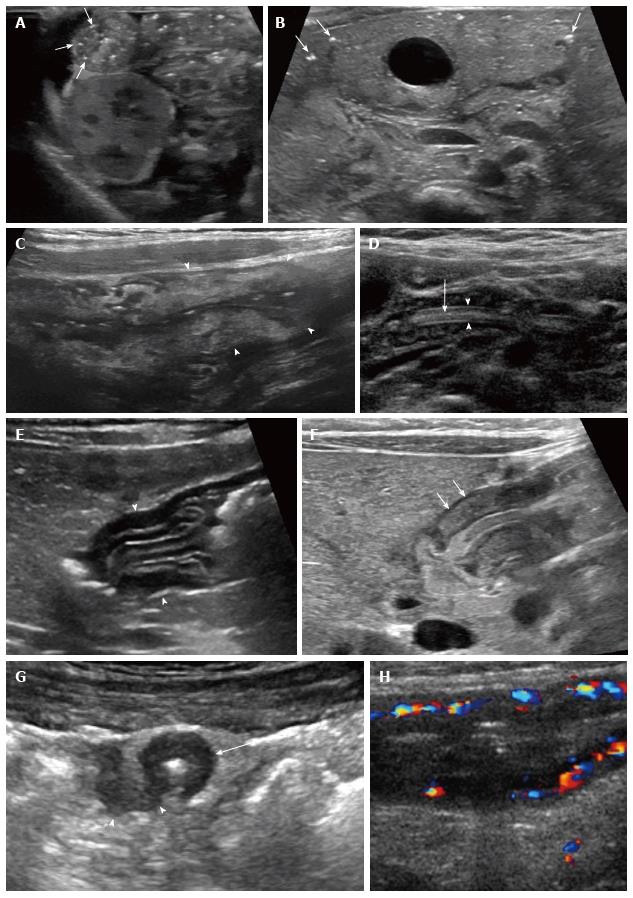Copyright
©The Author(s) 2016.
World J Radiol. Jul 28, 2016; 8(7): 656-667
Published online Jul 28, 2016. doi: 10.4329/wjr.v8.i7.656
Published online Jul 28, 2016. doi: 10.4329/wjr.v8.i7.656
Figure 4 Infectious and inflammatory bowel disorders.
A, B: Necrotizing enterocolitis. Targeted ultrasound of the abdomen in a premature infant shows bowel wall thickening and echogenic intramural air (A, arrows). This corresponded to an area of pneumatosis on recent radiograph (not shown). Transverse image of the liver show punctate, echogenic foci in the liver periphery, consistent with portal venous gas; the foci of air are too small to cause posterior artifact (B, arrows); C: Campylobacter enterocolitis. Ten-year-old with fever and abdominal pain with suspected appendicitis. Sagittal right lower quadrant ultrasound image shows mural thickening and increased echogenicity in the cecum and ascending colon (arrowheads). Stool cultures confirmed the diagnosis; D: Ascariasis. Two-year-old boy from Africa with abdominal pain. Ultrasound of the small bowel shows a mobile, hypoechoic, tubular structure with echogenic walls (arrowheads) and central linear echogenicity (arrow). Worms were later identified in the stool; E, F: Allergic (eosinophilic) gastritis. Ultrasound of the stomach in a 3-mo-old infant with persistent vomiting shows mural thickening in the antrum with prominent mucosal and submucosal layers (E, arrowheads). Endoscopy confirmed the diagnosis. Ultrasound of child with pyloric stenosis (F), for comparison, shows thickening primarily of the muscularis layer (arrows); G, H: Crohn disease. Transverse image of the right lower quadrant in a 15-year-old girl with longstanding Crohn disease shows a thick-walled ileum in cross section (arrow) with a fistula extending posterolaterally (arrowheads), confirmed with MRI (not shown) (G, arrows). Color Doppler ultrasound image in another patient with Crohn disease demonstrates mural thickening and hyperemia of the inflamed terminal ileum (H).
- Citation: Gale HI, Gee MS, Westra SJ, Nimkin K. Abdominal ultrasonography of the pediatric gastrointestinal tract. World J Radiol 2016; 8(7): 656-667
- URL: https://www.wjgnet.com/1949-8470/full/v8/i7/656.htm
- DOI: https://dx.doi.org/10.4329/wjr.v8.i7.656









